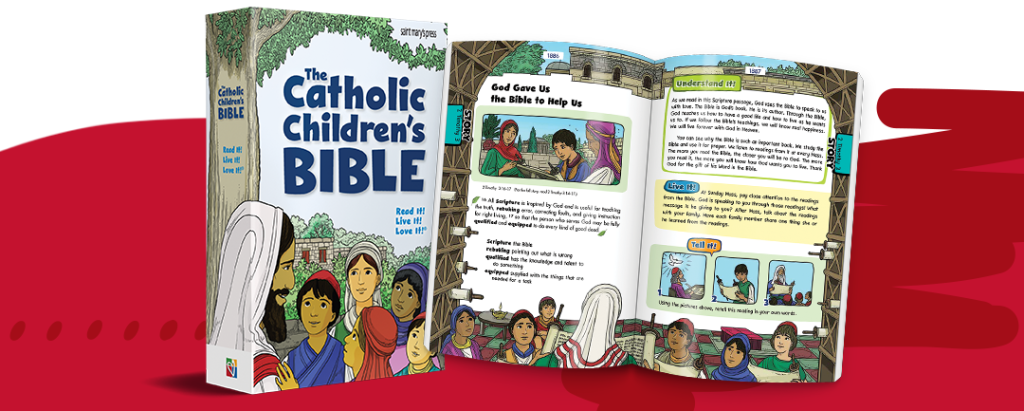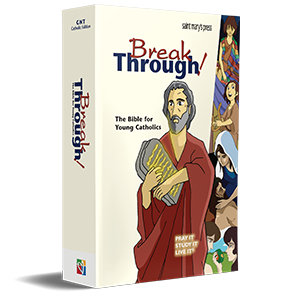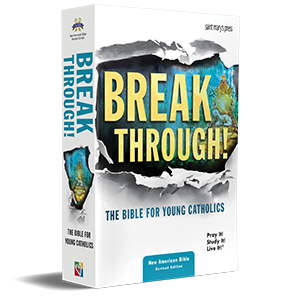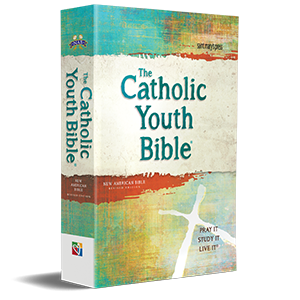
How to Choose the Right Catholic Bible for Children
Getting children into Scripture requires careful planning, especially when it comes to choosing the right Bible for them. With several options in terms of translations, formats, and features, it can be a bit overwhelming to know where to start. There are four main areas you will want to consider. By examining each as they relate to the children you are wanting to reach in your classroom, you can begin to narrow down the list and be led to the perfect Bible for your learning environment.
1: Define Your Main Goal
There are many different Catholic Bible products available for children; however, they come in many different formats. It is best to decide several things from the outset. First, what is the age group that you are hoping to reach? And what do you hope to accomplish with this age group? Do you want them to have a copy of the entire Bible—both Testaments–that they can work with and become familiar with, are you looking for just one Testament to focus their reading, or are you only looking for something that just presents key Bible stories?
2: Pick the Best Translation
The US Catholic bishops officially approve which translations are available for use throughout the United States. They ensure that the translations are acceptable and include the full Catholic canon of Scripture (this includes 7 more books than in most Protestant versions). You can find that list here. When you’re looking for Bibles that are specifically created and designed for children, however, you are essentially left with just a few translations to choose from.
The Good News translation can be particularly useful for children, as the language is much closer to the English we speak today. The phrasing and vocabulary has been adjusted for earlier readers and easier understanding while maintaining the accuracy of the original meaning.
Some people place a high value on having children use the Scripture text exactly as it is presented at Sunday Mass. If this is the top priority for you, then the New American Bible: Revised Edition translation will be something you want to look for. While not specifically written in a way that will be easily understood by children, it is the translation that Catholic Churches use on Sunday for liturgy.
3: Determine Key Special Features
Picking the best Bible for children requires careful attention to more than just the translation. Many children learn particularly well when they’re given visually-engaging materials, so the look and layout of the Bible you choose matters, as it will be integral to helping them understand what they’re reading. Bibles with colorful illustrations will both hold young ones’ attention while illustrating what they’re reading, giving them multiple ways to understand the story on the page. Readability is another important feature in children’s Bibles. Checking the text size, spacing, and blocking can make a world of difference for a child. So when you’re choosing the best Bible, you can narrow down your options by simply taking a look inside and asking yourself: “Will this be easy to read for children? Has the publisher designed this specifically for the way children read best?”
Other features a children’s Bible might have that can be helpful are special illustrations for key stories, vocabulary assistance, features that help interpret the text for a child, reading plans, maps, Catholic prayers, and maybe even an interactive feature, such as stickers that can be used to mark key passages or favorite Scripture stories.
4: Imagine It in Your Classroom
Educating young ones on the beauty of Scripture becomes much easier when you integrate the Bible into your daily classroom. That means choosing the right Bible requires planning how you’ll use it in class.
Some things for you to keep in mind:
- Is it easy to navigate? Using a Bible in class is a great way to help kids learn how to navigate and explore the rich library of texts in Sacred Scripture, but having a Bible that’s hard to parse can lead kids to more frustration than joy. You want them to be glad when they open their Bibles, so it’s important to find one that’s easy for them to open up and find what they’re looking for. Individually color-coded books, large tables of contents, and eye-catching opening pages are great ways to visually lead kids through Scripture!
- Is it engaging? Holding kids’ attention lays a foundation for active, engaging lessons. Having a children’s Bible that engages them with bright artwork and age-appropriate content can go a long way in class and at home – when kids are engaged with their Bible, they’re ready to go deeper in their lessons!
- Will it last? This one is less content-focused, but it’s equally important: can your children’s Bible last throughout childhood (in one piece, no less)? Kids love their Bibles, and that means those same Bibles can end up in some less-than-ideal situations. Having a set of Bibles with solid construction might not seem top of mind when you start looking, but it’s a first step that can prevent a lot of headaches down the road.
Picking a Bible for kids is a difficult task, but it’s also important. You’re setting the base for a lifetime of loving and living Scripture, and that’s quite the responsibility! We hope these tips are useful to you as you work to build biblical literacy in your young ones. Please contact us if we can help you if we can assist you in any way.





